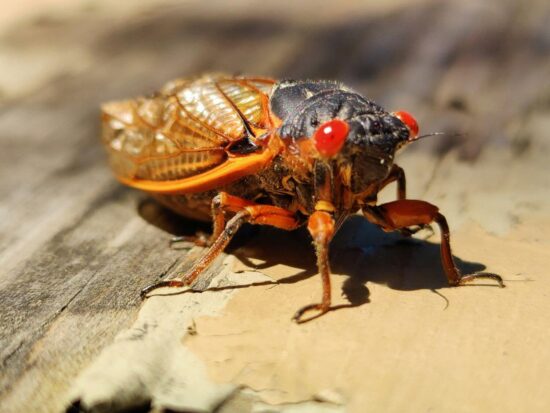Nothing ruins a peaceful summer evening quite like the deafening buzz of thousands of cicadas. These large, noisy insects can turn your backyard into a scene from a horror movie, especially during those massive 13 or 17-year emergences.
While completely eliminating these pests might be impossible, learning how to get rid of cicadas becomes much easier when you have the right strategies.
1. Apply Broad-Spectrum Insecticides for Immediate Control
The fastest way to tackle a cicada problem is with professional-grade insecticides. Products like Supreme IT work incredibly well because they kill cicadas on contact and keep working for up to 90 days. This means you get both immediate relief and long-term protection.
Apply the insecticide to your entire yard, including trees, shrubs, and lawn areas. Pay special attention to window frames, door frames, and any cracks around your home’s foundation. Create a protective barrier by spraying 3 feet out from your house and 3 feet up the walls.
Timing is everything with insecticide treatments. For annual cicadas, apply the product in early spring and late summer. If your area is expecting a massive periodical emergence, start treating about a month before they’re predicted to show up. This gives you the best chance of stopping them before they take over.
The key to success is thorough coverage. Don’t just spray a few trees and call it good. Cicadas are strong fliers and will quickly move to untreated areas. A complete yard treatment gives you the best results.
2. Install Physical Barriers with Fine Mesh Netting
Sometimes the best defense is a physical barrier. Fine mesh netting works like armor for your valuable plants and young trees. The trick is using mesh with holes smaller than 1/4 inch so cicadas can’t squeeze through.
Cover the entire plant from top to bottom, making sure the netting reaches all the way to the ground. Secure it tightly around the base so cicadas can’t crawl underneath. This method works especially well for protecting new trees and expensive ornamental plants.
Young trees under four years old need the most protection since cicadas prefer to lay their eggs in tender branches. Wrap these saplings completely and tie the netting securely around the trunk. The netting should be snug but not so tight that it bends or damages the branches.
Don’t forget to check your barriers regularly. Wind, rain, and curious pets can create gaps that give cicadas an opening. A small hole in your defense can let hundreds of cicadas through, so stay on top of maintenance.
3. Use Natural Essential Oil Repellents
- Plant-based peppermint oil formula repels pests naturally
- Safe to use around pets, kids, and indoor living spaces
- Great for garages, attics, baseboards, and outdoor areas
- Fresh mint scent with long-lasting protection
For those who prefer natural solutions, essential oils pack a powerful punch against cicadas. The strong scents of peppermint, lavender, and eucalyptus naturally repel these insects without using harsh chemicals.
Mix about 12 drops of peppermint oil with a gallon of water in a spray bottle. Add a small amount of dish soap to help the mixture stick to plants. Spray this solution directly on trees and shrubs where cicadas like to hang out.
Getting rid of cicadas with essential oils requires frequent reapplication, especially after watering or rain. The scent fades quickly, so plan to spray every few days during peak cicada season. Some people find that combining different oils works better than using just one type.
The biggest advantage of essential oils is safety. You can spray them around kids, pets, and food plants without worry. However, test a small area first to make sure the oils don’t damage sensitive plants.
4. Apply Neem Oil as Natural Insecticide
No products found.
Neem oil works differently from other natural treatments because it actually messes with cicadas’ internal systems. When cicadas absorb neem compounds, it confuses their hormones and makes them unable to reproduce properly.
Make a neem oil spray by mixing 2 tablespoons of pure, cold-pressed neem oil with a gallon of water. Add a few drops of dish soap to help everything mix together. Spray this solution directly on cicadas for the best results, making sure to completely drench them.
While neem oil is considered natural and safe, it works slowly compared to chemical insecticides. Large, hardy insects like cicadas might not be as affected as smaller pests. However, it’s still worth trying, especially if you want to avoid synthetic chemicals.
The best part about neem oil is that you can use it as both a treatment and a preventive measure. Spray it on plants before cicadas arrive to make your yard less attractive to them.
5. Wrap Tree Trunks to Block Climbing Access
After cicadas emerge from the ground, they immediately start looking for trees to climb. Wrapping tree trunks creates a barrier that stops them in their tracks. This simple method for getting rid of cicadas dramatically reduces the number that will make it into your trees.
Use materials like burlap, netting, or even aluminum foil to wrap around tree trunks. Make sure the wrapping goes all the way around and overlaps so there are no gaps. Secure it tightly but not so tight that it damages the bark.
Aluminum foil works surprisingly well because cicadas can’t get a good grip on the smooth surface. It also prevents them from laying eggs in the trunk area. Just make sure to remove it eventually so it doesn’t interfere with the tree’s growth.
Check your trunk wraps regularly and repair any damage. Determined cicadas will look for even the smallest opening to get through your defenses.
6. Spray Cicadas Off Plants with Garden Hose
Sometimes the simplest solutions work best. A strong blast from your garden hose can knock cicadas off plants and encourage them to move somewhere else. This method works great for small numbers of cicadas and doesn’t harm the insects or your plants.
Use a spray nozzle to create a powerful stream of water. Aim directly at the cicadas and spray them off branches and leaves. Most cicadas will fly away to find a more peaceful spot, hopefully in your neighbor’s yard.
This technique works best when combined with other methods. While it might not solve a major infestation, it can help manage smaller populations and give you temporary relief. It’s also satisfying to watch the cicadas get blasted away.
The water spray method is completely safe for organic gardens and won’t harm beneficial insects. It’s also free, which makes it perfect for people on a tight budget.
7. Maintain Proper Lawn Care and Landscaping
A well-maintained yard is naturally less attractive to cicadas. These insects prefer areas with lots of hiding spots and easy access to their favorite plants. By keeping your landscape neat and tidy, you make your property less appealing to them.
Keep trees and shrubs properly trimmed to eliminate hiding places where cicadas like to gather. Remove dead branches and overgrown areas that provide shelter. A clean, open landscape gives cicadas fewer places to establish themselves.
Thick, healthy grass also helps prevent cicada killers (wasps that hunt cicadas) from digging burrows in your lawn. Apply lime and fertilizer regularly, and water frequently to promote dense turf growth. Bare soil areas are like welcome mats for digging insects.
Good landscaping practices work year-round to make your property less attractive to all kinds of pests. It’s one of the best long-term strategies for keeping cicadas and other unwanted insects away.
8. Seal Home Entry Points and Install Quality Screens
While cicadas prefer to stay outdoors, they sometimes accidentally fly into homes through open doors and windows. The best way to keep them out is by making sure your home is properly sealed.
Check all window screens for holes or tears and repair them immediately. Even small gaps can let cicadas inside, and these large insects are hard to catch once they’re in your house. Make sure screens fit tightly in their frames with no gaps around the edges.
Seal any significant gaps around doors and windows with weatherstripping. Keep doors and windows closed during peak cicada activity, usually in the evening when they’re most active. If you need ventilation, make sure your screens are in perfect condition.
Don’t forget about other entry points like fireplace flues, attic vents, and gaps around utility lines. A few minutes spent sealing these openings can save you hours of chasing cicadas around your house.
9. Reduce Outdoor Lighting That Attracts Cicadas
Like many insects, cicadas are drawn to bright lights at night. Reducing outdoor lighting during cicada season can help keep them away from your home and outdoor living areas.
Turn off unnecessary outdoor lights, especially decorative lighting and porch lights. If you need some outdoor lighting for safety, consider using motion-activated lights that only come on when needed. Amber-colored lights are less attractive to insects than white or blue lights.
Close curtains and blinds at night to prevent indoor light from attracting cicadas to your windows. This simple step can dramatically reduce the number of cicadas that gather around your home in the evening.
Remember that using this method to get rid of cicadas works best when combined with other control strategies. While reducing lights helps, it won’t solve a major cicada problem by itself.
10. Encourage Natural Predators in Your Yard
Nature has its own way of dealing with cicadas. Many birds, bats, and other animals love to eat these protein-rich insects. By encouraging natural predators, you can get help controlling cicada populations without doing any work yourself.
Set up bird feeders and bird houses to attract cicada-eating birds like cardinals, blue jays, and woodpeckers. Install bat houses to encourage these flying mammals that hunt insects at night. Even some beneficial insects like praying mantises will help control cicadas.
Create a diverse habitat with native plants that support beneficial wildlife. Avoid using pesticides that could harm the predators you’re trying to attract. A healthy ecosystem naturally keeps pest populations in check.
While natural predators won’t eliminate every cicada, they can make a significant dent in the population. Plus, you’ll enjoy watching birds and other wildlife in your yard.
11. Time Yard Work to Avoid Peak Cicada Activity
Cicadas are most active during the warmest parts of the day and can be confused by the vibrations from power tools. Plan your yard work for early morning or evening when these insects are less active.
Loud equipment like lawn mowers, leaf blowers, and chainsaws can actually attract cicadas because the vibrations sound similar to their mating calls. If you must use power tools during cicada season, try to work quickly and be prepared for some unwanted attention.
Wear a wide-brimmed hat when working under trees to protect yourself from cicada droppings. These insects excrete excess liquid that can irritate your skin. Long sleeves and pants also provide protection if cicadas decide to land on you.
Scheduling major yard projects before or after peak emergence periods is the smartest approach. A little planning can save you a lot of hassle and make your outdoor work much more pleasant.
12. Cover Pools, Hot Tubs, and Water Features
Cicadas aren’t great swimmers, and they’ll drown if they fall into pools or hot tubs. While this might sound like a good thing, dealing with hundreds of dead cicadas in your pool is gross and time-consuming.
Cover your pool and hot tub during major cicada emergences to prevent this messy problem. Use a solid cover or fine mesh that won’t let cicadas through. Keep covers on for the entire cicada season in your area.
Don’t forget about smaller water features like fountains and bird baths. Even these can become cicada graveyards during heavy infestations. Consider covering or temporarily draining them during peak season.
Clean any cicadas that do fall in your water features immediately. Dead insects can affect water quality and clog filters and drains.
13. Plant Timing and Garden Protection Strategies
Smart gardening decisions can help you avoid cicada problems before they start. These insects prefer certain types of plants and are especially attracted to new growth and fresh cuts.
Delay planting new trees and shrubs until fall if you know cicadas are coming. This gives plants time to establish themselves without the stress of cicada damage. Avoid major landscaping projects during expected emergence years.
Postpone pruning until after cicadas have finished their life cycle and died off. Fresh cuts attract egg-laying females, and new growth is especially vulnerable to damage. If you must prune, remove and dispose of any branches that show signs of cicada eggs.
When cicadas do lay eggs in your plants, you can prune off affected branches and throw them away. This helps reduce the next generation’s population and prevents damage to your valuable plants.
14. Professional Pest Control Services
Sometimes the best approach to how to get rid of cicadas is calling in the experts. Professional pest control companies have specialized equipment, stronger products, and the experience to handle major infestations effectively.
Pest control professionals can assess your specific situation and create a customized treatment plan. They have access to commercial-grade products that aren’t available to homeowners and know exactly how to apply them for maximum effectiveness.
Many companies provide same-day or next-day service, which is crucial during sudden cicada emergences. They can also advise you on long-term prevention strategies and help you prepare for future cicada seasons.
While professional service costs more than DIY methods, it might be worth it for valuable landscapes or severe infestations. Getting rid of cicadas quickly can prevent extensive damage to young trees and ornamental plants.
15. Proper Cleanup and Dead Cicada Removal
Even successful cicada control creates a new problem: what to do with all the dead bodies. Proper cleanup is essential for health, safety, and preventing other pest problems.
Remove dead cicadas promptly because they attract scavengers and can create unpleasant odors as they decompose. Use a shovel or rake to collect them, and be prepared for large quantities during major die-offs.
Dead cicadas can be buried, composted (if no pesticides were used), or thrown away with regular trash. Don’t leave them lying around because they can attract ants, flies, and other unwanted pests.
Be especially careful if you use insecticides because the chemical residue can be dangerous to pets and wildlife that might try to eat the dead cicadas. Store treated carcasses safely until disposal.



